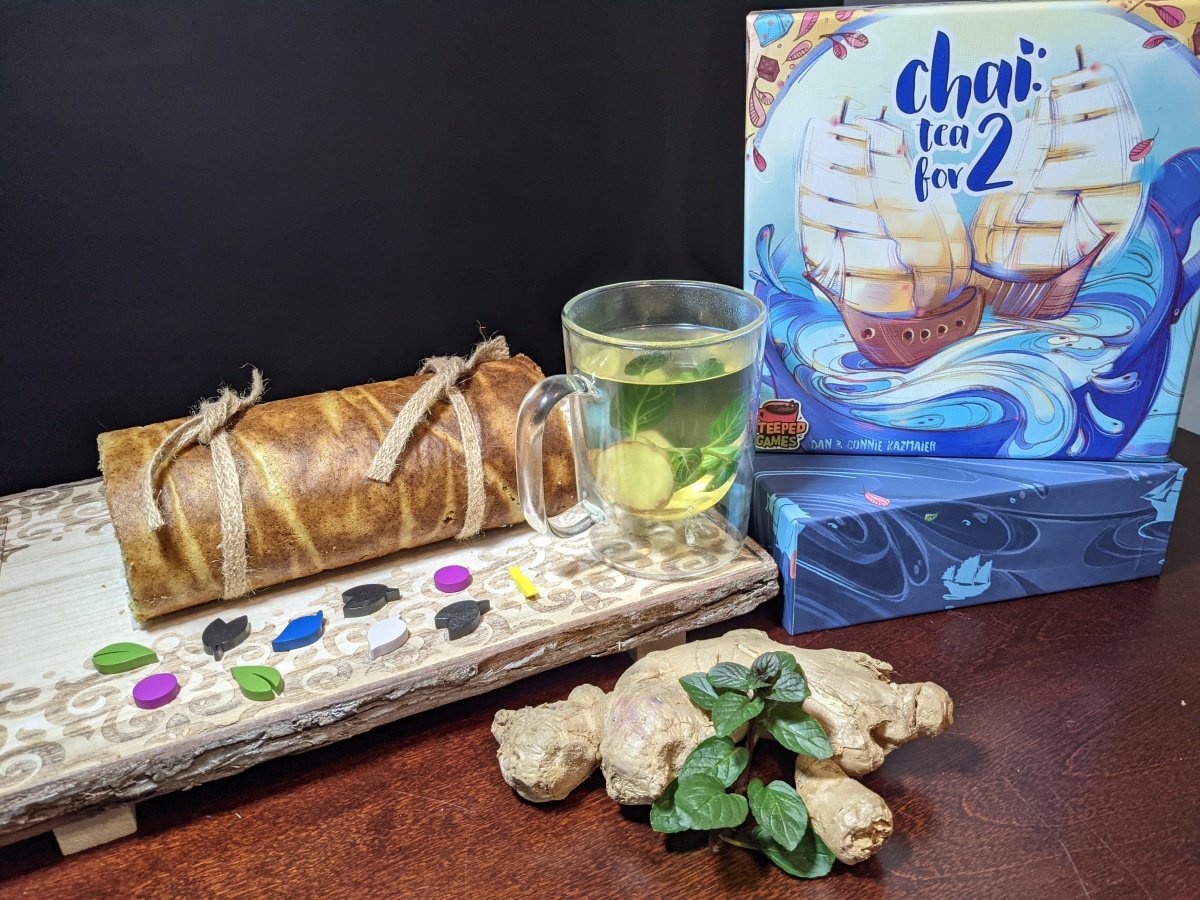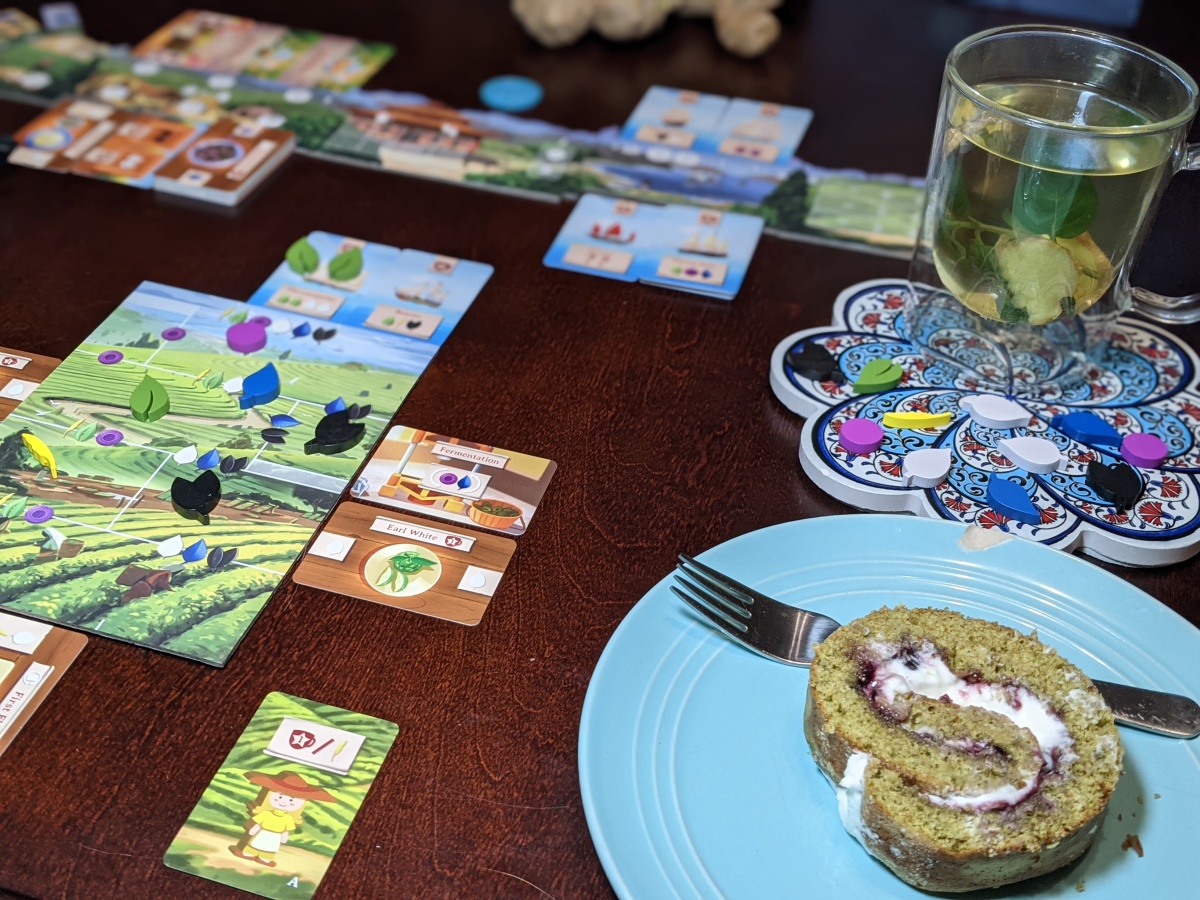Chai: Tea for 2
Designers: Dan Kazmaier, Connie Kazmaier
Artist: Andrew Bosley, Mary Haasdyk, Sahana VJ
Publisher: Steeped Games
Review copy of the game provided
Many a game has been enjoyed over a cuppa hot stuff, whether it’s the Twinings tea bag hurriedly thrown into a Styrofoam cup at a convention, or the herbal brew lovingly steeped at home. 2019’s Chai from Steeped Games brought a taste of this custom to the games table itself. While a relatively simple game, it embraced the ritual of tea-making in a wonderfully immersive way.
Now designers Dan and Connie Kazmaier are back with a new take on the tradition of tea-making, once again steeping their love of the subject into every aspect. Chai: Tea for 2 turns it’s attention to the manufacture and distribution of tea in the 1800’s. Not only is it a dedicated 2 player game (including a solo variant) but also a sharp step up in complexity, reflecting the complicated tea-making process it’s modeling. You’re going to need a caffeinated variety for this one…
The Game

Chai: Tea for 2 sees two rival merchants competing to manufacture and ship tea from China across the world. You’ll be collecting various types of tea, moving them through the manufacture process, buying cards to speed up that process and contracting ships to send off your refined products.
Most of these actions are completed by each player rolling a set of 7 dice, and taking turns placing them in preset action slots. Some of these spaces require 1 dice of a particular number, some require several dice of the same number, and others require a sequence of consecutive numbers.
Some actions allow you to one-up your opponent by dropping dice of higher numbers or a larger set, creating a devious decision. Do you drop a set of 4+5+6 dice to claim a valuable ship, or do you risk a smaller 1+2 set and save your high dice for buying lucrative cards. You’ll need to carefully balance the order in which you take your actions to maximize how many you can take while blocking your opponent.

The truly innovative and exciting part of the game though is the Plantation board, where each player will be tracking the manufacture of their tea tokens. This functions as something as a flowchart as your tea tokens move through along a predetermined path from initial harvest to reach the docks. It’s a slow process, but you have several tricks in your teabag to speed it up. You can spend dice sets for movement points but risk being outbid by your opponent. Or you can buy cards in the market that customize how your production line functions. A card might give free movement to all tea tokens of one color; it might grant movement to multiple colors but need a dice placement to re-activate it; it might provide crates for smaller, secondary contracts to fill for a tasty sip of points.
I’ve not had the chance to play enough for a full review (Canada is unfortunately quite slow in rolling out the Covid vaccines). But it’s a tea-riffic production. The designers love of the theme is apparent in all aspects of the game, from historical notes to mechanical flourishes like one type of tea oxidizing into another. The spatial puzzle of navigating the plantation board is a lot of fun, whether that’s outsmarting and outbidding your opponent, or a clever combo of card synergies. You have plenty of options to help improvise with a bad roll of the dice.
I have played several games of the solo mode and had a lot of fun. Each round a card is drawn dictating where your opponents dice will be placed. Once the card is revealed the results of the round are a purely deterministic affair, so with careful planning you can usually take all the actions you need to do. You lose a good chunk of depth in the uncertainty of your opponents placements and outbidding you but you still have the joy of the navigating the plantation board and puzzling through your optimal turn.
The Feast
Designing a dish to pair with the game was a cup of tea. It goes without saying that a brewed beverage was compulsory, and I certainly have many types of tea to choose from (100+ on last count). I’ve created several cocktails to pair with games before but this was a fun exercise in creating a light, non-alcoholic beverage.

First up for a light savory meal, we have mushroom tea. No, not *those* mushrooms, we’ll need our wits about us for this game. One might argue it’s actually more of a broth, steeped with dashi kombu, shiitake mushrooms and green onion. Nevertheless, it’s warm, tasty, and ready to perk up your brain cells.

With our main out of the way, we can move on to something something refreshing for afternoon tea. While I have an eclectic taste in tea, my preferred pot is anything with ginger and/or mint. Here we have both, with a touch of lemon zest. Inspiration for both brews came from the Heroes Feast Dungeons and Dragons cookbook.

But it wouldn’t be afternoon tea without something sweet to snack on. I wanted to infuse some tea into an edible treat and having enjoyed the matcha cake I made for The One Hundred Torii, I repurposed that into a swiss roll, filled with jam and cream. The perfect snack for an afternoon ‘high’ tea.





Hello! I simply would like to offer you a huge thumbs up for the great information you have right here on this post. I will be coming back to your blog for more soon.
vnIwGQYqT